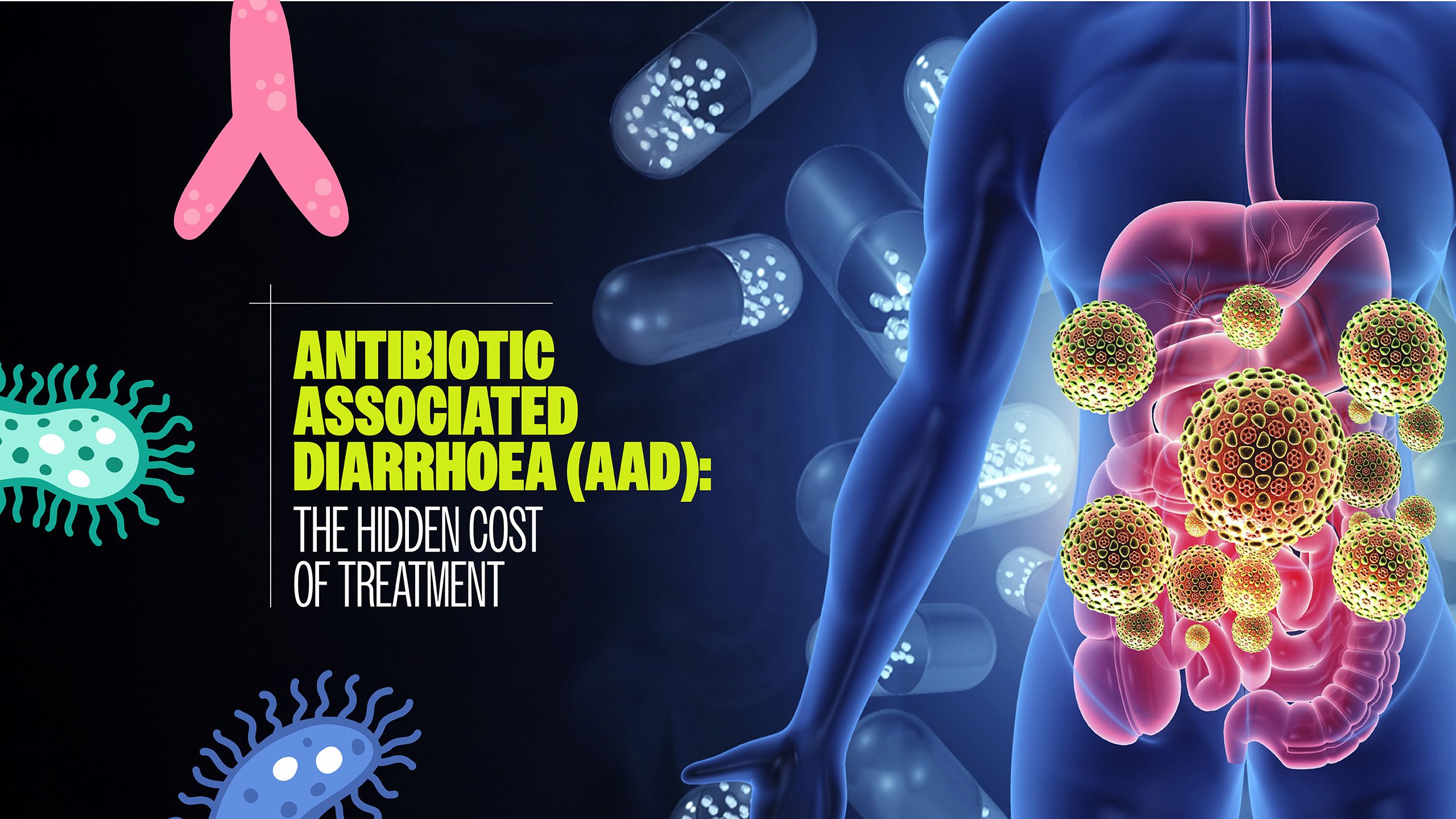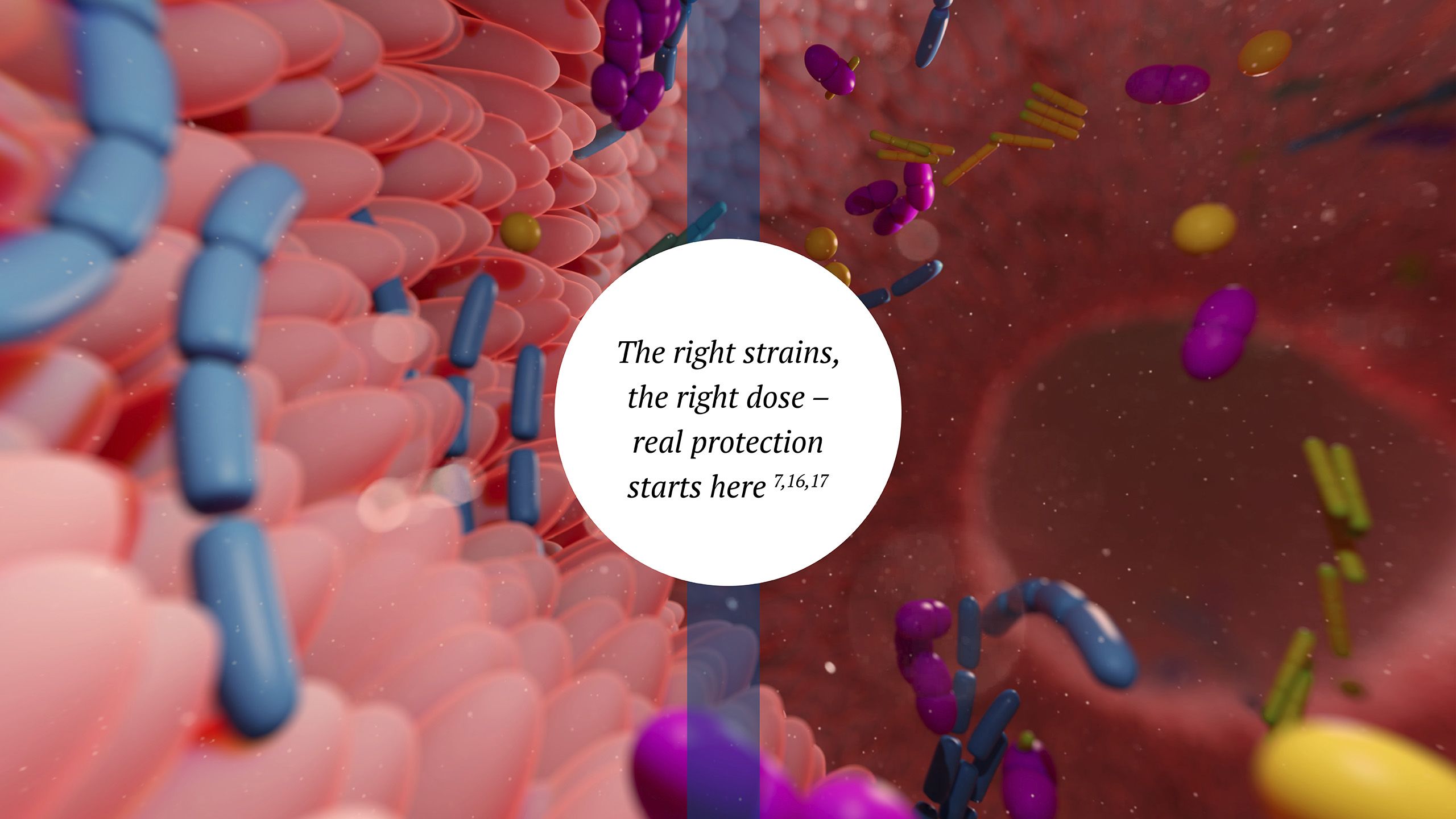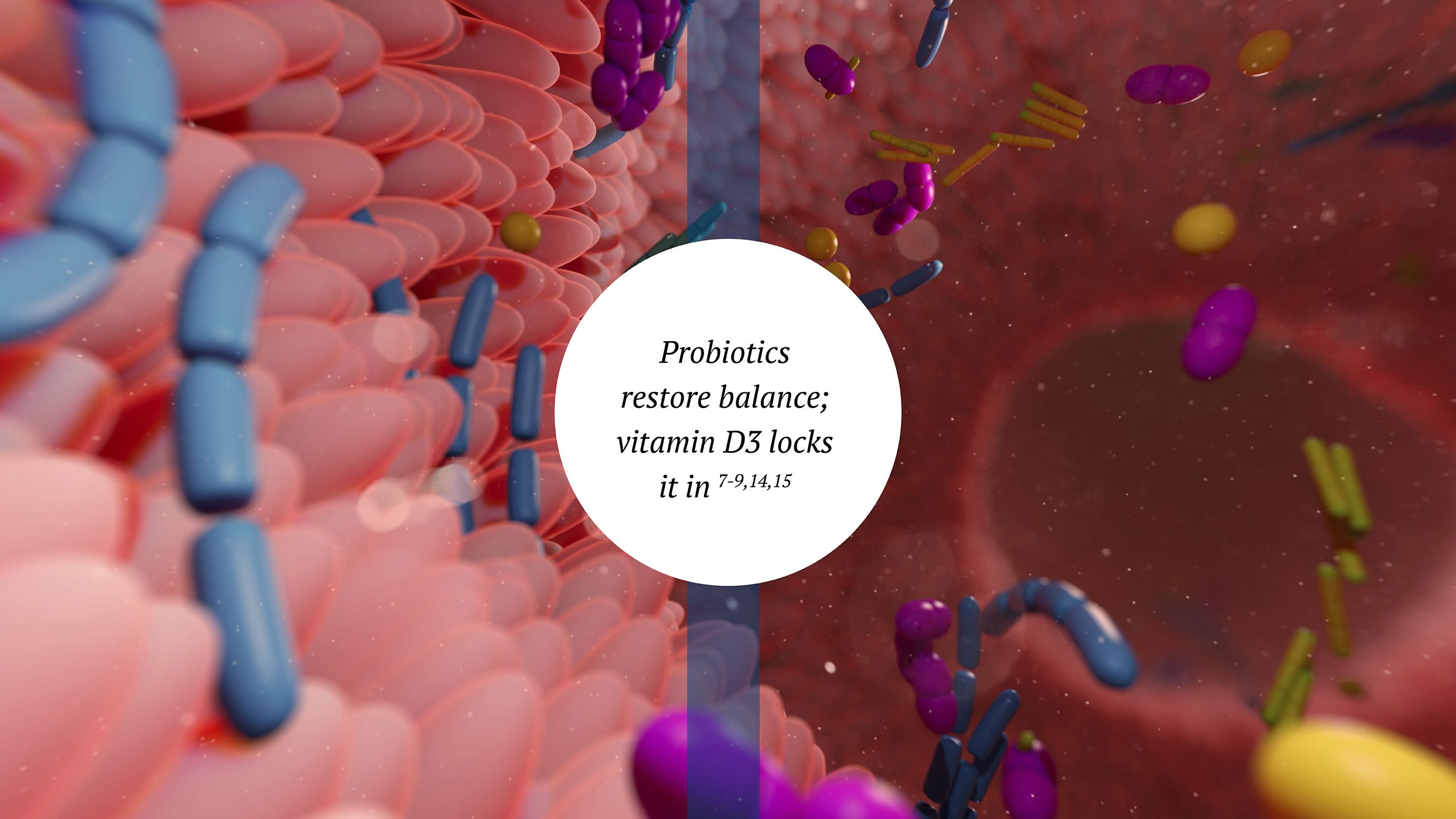
Antibiotic‑associated diarrhoea (AAD) is a common complication of antibiotic therapy, affecting up to 30% of patients.1-3 It results from disruption of the gut microbiota, allowing opportunistic pathogens such as Clostridioides difficile to proliferate.4 The consequences range from mild discomfort to life‑threatening colitis, prolonging hospital stays and increasing healthcare costs.2,3


PROBIOTICS: THE GUT’S DEFENCE SYSTEM
Probiotics are live microorganisms which, when administered in adequate amounts, confer a health benefit on the host. 4 They restore microbial balance, enhance mucosal barrier function, and modulate immune responses.5,6 Mechanisms include competitive exclusion of pathogens, production of antimicrobial compounds (e.g., bacteriocins), and stimulation of secretory IgA.4
WHY MULTISTRAIN BEATS SINGLESTRAIN
Multistrain probiotic formulations combine complementary species to deliver broader benefits than single strains.7,8 This approach leverages functional redundancy (multiple strains performing similar protective roles) and strain‑specificity (unique actions targeting different pathways). Timmerman et al.8 demonstrated that multistrain products can outperform singlestrain equivalents in preventing gastrointestinal infections.
KEY STRAINS & BENEFITS
- Lactobacillus acidophilus: Enhances mucosal immunity and inhibits pathogen adhesion.7
- Bifidobacterium breve: Produces short‑chain fatty acids, lowering gut pH to suppress pathogens.7
- Streptococcus thermophilus: Improves lactose digestion and supports epithelial repair.7
- Lactobacillus helveticus: Exhibits psychotropic and ACE‑inhibitory properties, potentially reducing stress‑related gut symptoms.9


CFU COUNT MATTERS
Colony‑forming units (CFUs) quantify viable bacteria in a probiotic dose.10,11 Higher CFU counts can improve survival through gastric acid and bile, increasing colonisation potential.12,13 McFarland14 found that doses ≥ 100 billion CFU/day were more effective in preventing AAD than lower doses. Stability over shelf life is critical — a high CFU at manufacture must remain high until expiry.
VITAMIN D3 SYNERGY
Vitamin D3 enhances gut barrier integrity and modulates immune responses via the vitamin D receptor (VDR).15 Probiotics can upregulate VDR expression, creating a synergistic effect. This combination may also influence the gut–lung axis, offering systemic immune benefits.
CONCLUSION
AAD remains a significant clinical challenge. Evidence supports the use of high‑CFU, multistrain probiotics — potentially combined with Vitamin D3 — to reduce incidence and severity. Product selection should be guided by strain specificity, CFU count and stability, and supporting clinical data.
REFERENCES
- Alabi ME, Essack SY. Antibiotic prescribing amongst South African general practitioners in private practice: an analysis of a health insurance database. JAC Antimicrob Resist 2022;4(5):dlac101. https://doi.org/10.1093/jacamr/dlac101
- Agamennone V, Krul CAM, Rijkers G, Kort R. A practical guide for probiotics applied to the case of antibiotic-associated diarrhoea in The Netherlands. BMC Gastroenterology 2018;18:103. https://doi.org/10.1186/s12876-018-0831-x
- Varughese CA, Vakil NH, Phillips KM. Antibiotic-associated diarrhoea: a refresher on causes and possible prevention with probiotics - continuing education article. J Pharm Pract 2013 Oct;26(5):476-82. http://doi.org/10.1177/0897190013499523.
- Stavropoulou E, Bezirtzoglou E. Probiotics in Medicine: A Long Debate. Front Immunol 2020;11:2192. http://doi.org/10.3389/fimmu.2020.02192.
- Doar NW, Samuthiram SD. Qualitative Analysis of the Efficacy of Probiotic Strains in the Prevention of Antibiotic-Associated Diarrhoea. Cureus 2023;15(6): e40261. http://doi.org/10.7759/cureus.40261.
- Avadhani A, Miley H. Probiotics for prevention of antibiotic-associated diarrhoea and Clostridium difficile-associated disease in hospitalized adults - A meta-analysis. J Am Acad Nurse Pract 2011;23(6):269-74. http://doi.org/10.1111/j.1745-7599.2011.00617.x.
- Cheng FS, Pan D, Chang B, et al. Probiotic mixture VSL#3: An overview of basic and clinical studies in chronic diseases. World J Clin Cases 2020;8(8):1361-1384. http://doi.org/10.12998/wjcc.v8.i8.1361.
- Selinger CP, Bell A, Cairns A, et al. Probiotic VSL#3 prevents antibiotic-associated diarrhoea in a double-blind, randomised, placebo-controlled clinical trial. J Hosp Infection 2013;84:159-165. http://dx.doi.org/10.1016/j.jhin.2013.02.019
- Latif A, Shehzad A, Niazi S, et al. Probiotics: mechanism of action, health benefits and their application in food industries. Front Microbiol 14:1216674. doi: 10.3389/fmicb.2023.1216674
- International Scientific Association for Probiotics and Prebiotics. Dispelling Probiotic Myths (2023). https://isappscience.org/wp-content/uploads/2023/04/Dispelling-Probiotic-Myths.pdf. Accessed 8 April 2025.
- Bezkorovainy A. Probiotics: determinants of survival and growth in the gut. Am J Clin Nutr 2001;73(suppl):399S-405S.
- Guo Q, Goldenberg JZ, Humphrey C, et al. Probiotics for the prevention of pediatric antibiotic-associated diarrhoea. Cochrane Database of Systematic Reviews 2019, Issue 4. Art. No.: CD004827. http://dx.doi.org/10.1002/14651858.CD004827.pub5.
- Akimbekov NS, Digel I, Sherelkhan DK, et al. Vitamin D and the Host-Gut Microbiome: A Brief Overview. Acta Histochem Cytochem 2020;53(3):33-42. http://doi.org/10.1267/ahc.20011.
- Eskesen, D., et al. (2015). Effect of the probiotic strain Bifidobacterium animalis subsp. lactis, BB-12, on defecation frequency in healthy subjects with low defecation frequency and abdominal discomfort. British Journal of Nutrition, 114(10), 1638-1646. DOI: 10.1017/S0007114514003667
Image Credit: Getty Images



